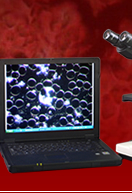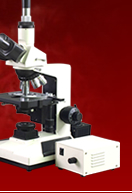
The Stem of a Plant under a Microscope
For our science microscope activity, we will be examining the stem of a plant under the microscope. This can prove to be a very interesting as well as educational activity for students and children alike especially those from high school and elementary. In this experiment we will also be using a high power compound light microscope to see with greater magnification.The stem is the part of the plant that shoots up from the ground and holds the leaves and flowers together. But other than the stem being the structural part that binds the rest of the parts together, the stem also performs other vital activities for the plant. The stem carries the water and other nutrients that the roots absorb to the leaves. It also carries the food manufactured by the leaves back to the roots for nourishment.
We will be examining the stem under an educational high power compound microscope in order to know how it performs its functions. Kids and children may think that stems are all alike but in reality, some stems are different from the rest when it comes to structure when seen under a compound light microscope. To know about these differences, teachers should assign their students to bring a sunflower and corn stem to the classroom.
We will examine the stem of the sunflower under the science microscope to compare its similarities and differences with that of the structure of the root. The students may choose to obtain a sample of a root (preferably oat, radish or grass) but it is okay if they can’t find any. If you take a closer look at the cross-section of the sunflower stem under a high power school microscope, you will see that it is somehow similar to the structure to the root. You will see the outermost ring of cells that is the epidermis, the innermost part called the stele and the middle majority part called the cortex that is made up of parenchyma cells.
The first difference between the structure of the stem to the structure of the root as seen under the high power microscope is the stele or the innermost core. While the root is made up of xylem cells that have thick walls, the sunflower stem has parenchyma cells that are very thin and are collectively called the pith.
Another difference between the structure of the stem and the root that can be seen under the compound microscope is its vascular cylinder. The sunflower stem has patches of vascular tissues that are in a circle formation. These are called the vascular bundles. If we focus our microscope to one of these microscopic bundles, we will see the xylem at the center of the stem. The xylem has several cells of different kinds forming the trachea and tracheids. These are passageways for the water that go up the stem and they look like slender tubes. A trachea looks like a formation of short cells with thickened walls on the inside while tracheid cell looks elongated in shape and with pointed ends. If we cut a longitudinal section of the sunflower stem, we will be able to see the structure of the trachea and tracheid under the high power compound light microscope.
As we move outside from the stem’s center, we will see a small band of parenchyma cells. This is the cambium and its function is to form new cells. Next to this is the mass of narrow and thinly-walled cells that is the phloem. The narrow cells with thin walls are called the sieve-tubes that carry the food manufactured by the leaves downwards the stem.
Finally, if we focus on the outer area of the phloem using our educational microscope, the student will see a thick layer of cells. This is the stele and it is surrounded by a clump of hard fibers that is the outer part of the stele called the pericycle.
The structure of the sunflower stem that we examined under our high power compound light microscope is also common among many plants. There are, however, another group of plants that have a different stem structure. This is where we will use our corn stem which belongs to the group of grasses and cereal grains.
We shall cut a cross-section of the corn stem, mount it on the microscope slide and examine it under our biological compound light microscope. If you have another high power microscope at school, you can use it to compare the corn stem’s structure to that of the sunflower stem’s.
The most obvious difference that can be seen between the corn stem and the sunflower stem is that the stele and cortex are different. A corn stem under the high power compound microscope has an epidermis and vascular bundles that are scattered throughout the stem. Surrounding these bundles are the parenchyma cells that are also unlike those found in the sunflower stem.
If we focus on one of these vascular bundles, we will see that like the sunflower stem, it also has a xylem and phloem. But unlike a sunflower stem, it doesn’t have a cambium and the phloem (lying closest to the epidermis) is made up of sieve-tubes while the xylem (near the phloem) has four openings. Two of these can be found near the phloem and are called tracheal tubes due to the bordered pits that cover their surface. In between these tracheal tubes are a spiral and an annular tube. Surrounding these vascular bundles is the bundle sheath that is a group cells with thick walls and of several layers.
Since there is no presence of cambium that forms new cells, the stems of the plants don’t go any thicker when it reaches maturity and therefore the plant’s stems do not increase in diameter.
After performing this microscope activity, high school and elementary students can already categorize the stems of plants with the use of a high power compound light microscope.




